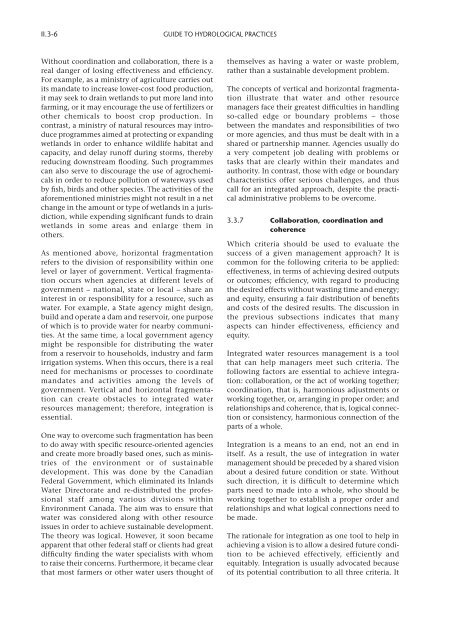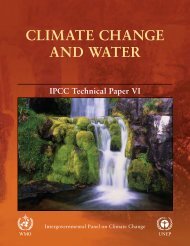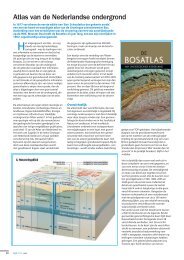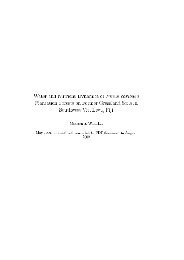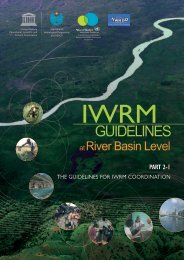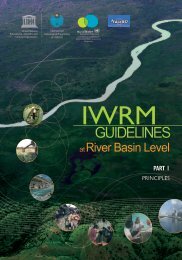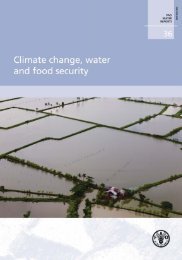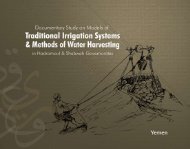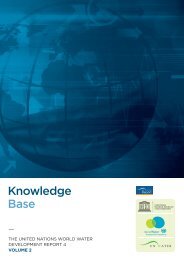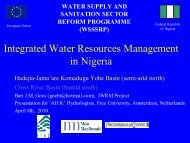Guide to Hydrological Practices, 6th edition, Volume II - Hydrology.nl
Guide to Hydrological Practices, 6th edition, Volume II - Hydrology.nl
Guide to Hydrological Practices, 6th edition, Volume II - Hydrology.nl
Create successful ePaper yourself
Turn your PDF publications into a flip-book with our unique Google optimized e-Paper software.
<strong>II</strong>.3-6GUIDE TO HYDROLOGICAL PRACTICESWithout coordination and collaboration, there is areal danger of losing effectiveness and efficiency.For example, as a ministry of agriculture carries outits mandate <strong>to</strong> increase lower-cost food production,it may seek <strong>to</strong> drain wetlands <strong>to</strong> put more land in<strong>to</strong>farming, or it may encourage the use of fertilizers orother chemicals <strong>to</strong> boost crop production. Incontrast, a ministry of natural resources may introduceprogrammes aimed at protecting or expandingwetlands in order <strong>to</strong> enhance wildlife habitat andcapacity, and delay runoff during s<strong>to</strong>rms, therebyreducing downstream flooding. Such programmescan also serve <strong>to</strong> discourage the use of agrochemicalsin order <strong>to</strong> reduce pollution of waterways usedby fish, birds and other species. The activities of theaforementioned ministries might not result in a netchange in the amount or type of wetlands in a jurisdiction,while expending significant funds <strong>to</strong> drainwetlands in some areas and e<strong>nl</strong>arge them inothers.As mentioned above, horizontal fragmentationrefers <strong>to</strong> the division of responsibility within onelevel or layer of government. Vertical fragmentationoccurs when agencies at different levels ofgovernment – national, state or local – share aninterest in or responsibility for a resource, such aswater. For example, a State agency might design,build and operate a dam and reservoir, one purposeof which is <strong>to</strong> provide water for nearby communities.At the same time, a local government agencymight be responsible for distributing the waterfrom a reservoir <strong>to</strong> households, industry and farmirrigation systems. When this occurs, there is a realneed for mechanisms or processes <strong>to</strong> coordinatemandates and activities among the levels ofgovernment. Vertical and horizontal fragmentationcan create obstacles <strong>to</strong> integrated waterresources management; therefore, integration isessential.One way <strong>to</strong> overcome such fragmentation has been<strong>to</strong> do away with specific resource-oriented agenciesand create more broadly based ones, such as ministriesof the environment or of sustainabledevelopment. This was done by the CanadianFederal Government, which eliminated its I<strong>nl</strong>andsWater Direc<strong>to</strong>rate and re-distributed the professionalstaff among various divisions withinEnvironment Canada. The aim was <strong>to</strong> ensure thatwater was considered along with other resourceissues in order <strong>to</strong> achieve sustainable development.The theory was logical. However, it soon becameapparent that other federal staff or clients had greatdifficulty finding the water specialists with whom<strong>to</strong> raise their concerns. Furthermore, it became clearthat most farmers or other water users thought ofthemselves as having a water or waste problem,rather than a sustainable development problem.The concepts of vertical and horizontal fragmentationillustrate that water and other resourcemanagers face their greatest difficulties in handlingso-called edge or boundary problems – thosebetween the mandates and responsibilities of twoor more agencies, and thus must be dealt with in ashared or partnership manner. Agencies usually doa very competent job dealing with problems ortasks that are clearly within their mandates andauthority. In contrast, those with edge or boundarycharacteristics offer serious challenges, and thuscall for an integrated approach, despite the practicaladministrative problems <strong>to</strong> be overcome.3.3.7 Collaboration, coordination andcoherenceWhich criteria should be used <strong>to</strong> evaluate thesuccess of a given management approach? It iscommon for the following criteria <strong>to</strong> be applied:effectiveness, in terms of achieving desired outputsor outcomes; efficiency, with regard <strong>to</strong> producingthe desired effects without wasting time and energy;and equity, ensuring a fair distribution of benefitsand costs of the desired results. The discussion inthe previous subsections indicates that manyaspects can hinder effectiveness, efficiency andequity.Integrated water resources management is a <strong>to</strong>olthat can help managers meet such criteria. Thefollowing fac<strong>to</strong>rs are essential <strong>to</strong> achieve integration:collaboration, or the act of working <strong>to</strong>gether;coordination, that is, harmonious adjustments orworking <strong>to</strong>gether, or, arranging in proper order; andrelationships and coherence, that is, logical connectionor consistency, harmonious connection of theparts of a whole.Integration is a means <strong>to</strong> an end, not an end initself. As a result, the use of integration in watermanagement should be preceded by a shared visionabout a desired future condition or state. Withoutsuch direction, it is difficult <strong>to</strong> determine whichparts need <strong>to</strong> made in<strong>to</strong> a whole, who should beworking <strong>to</strong>gether <strong>to</strong> establish a proper order andrelationships and what logical connections need <strong>to</strong>be made.The rationale for integration as one <strong>to</strong>ol <strong>to</strong> help inachieving a vision is <strong>to</strong> allow a desired future condition<strong>to</strong> be achieved effectively, efficiently andequitably. Integration is usually advocated becauseof its potential contribution <strong>to</strong> all three criteria. It


